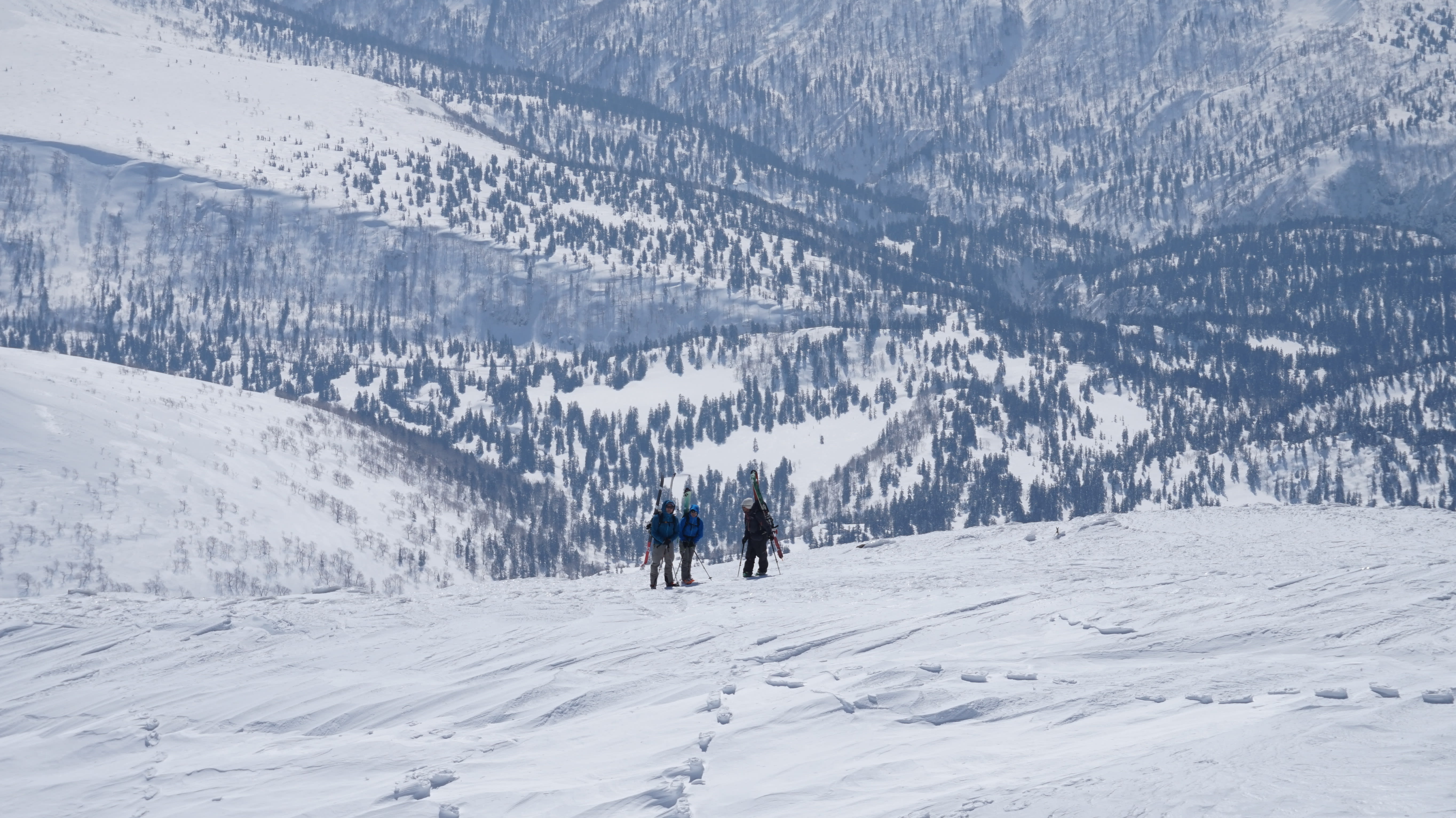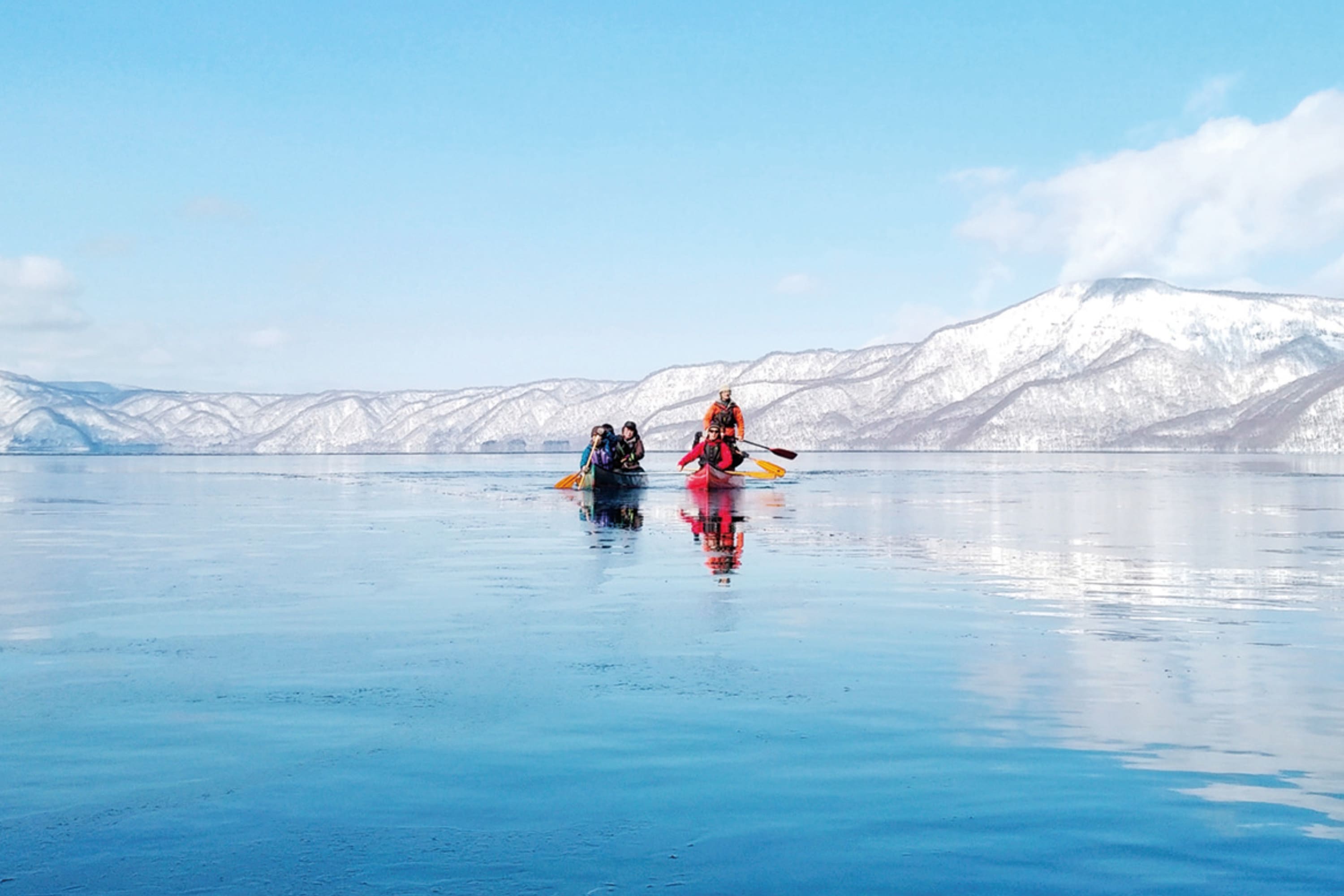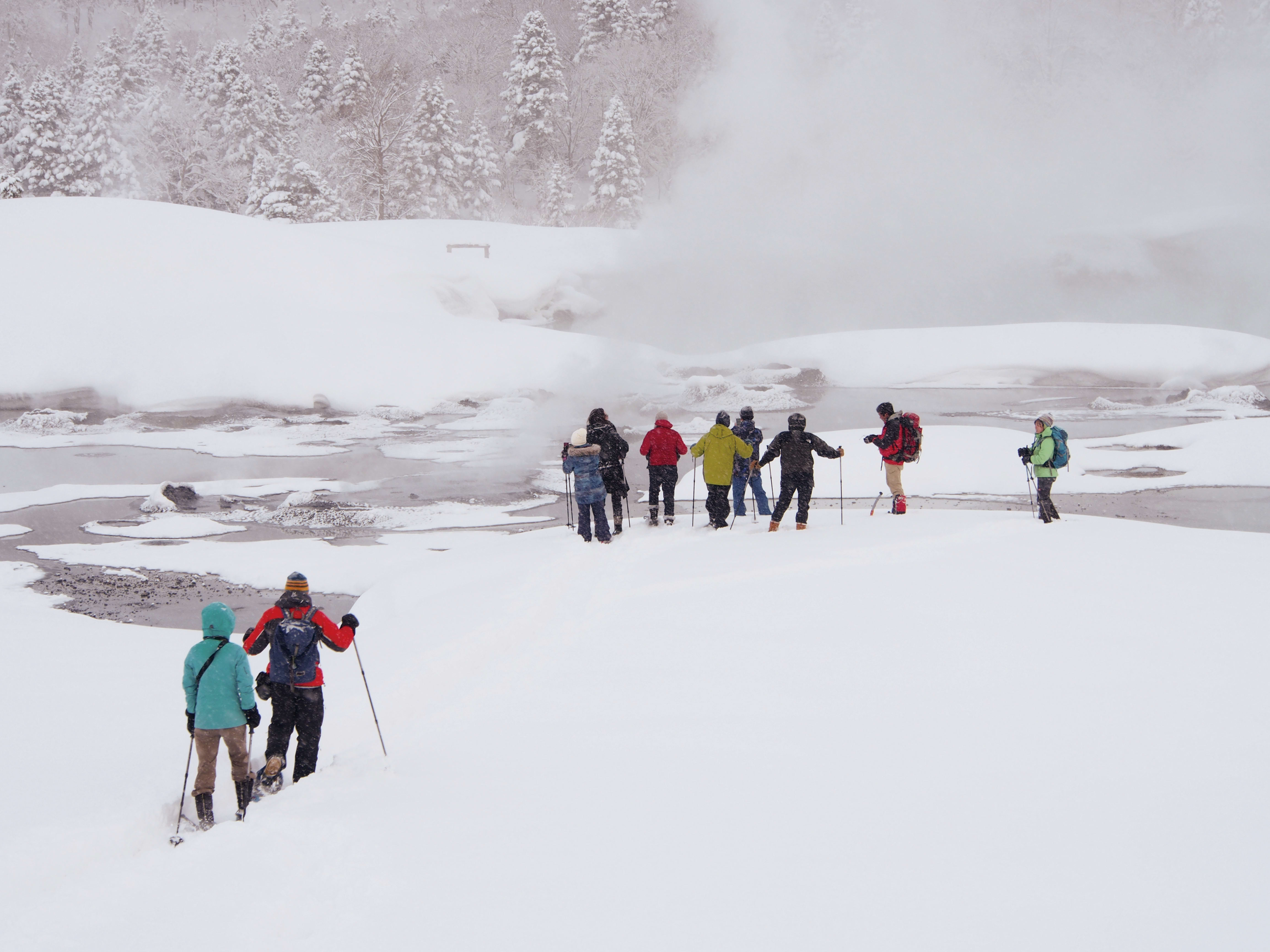
Snowshoeing in Towada-Hachimantai National Park's Hakkoda backcountry
Skiing and snowboarding heaven
The Japanese Alps, Hakkoda Mountains and Shiga Highlands are just a few of the mountainous areas of Japan’s national parks that offer world-class skiing and snowboarding–not to mention breathtaking views from the ski resorts' gondolas, ropeways and lifts.
Take advantage of Honshu and Hokkaido’s heavy winter snowfall and the hundreds of ski resorts that cater to all levels. There is a skiing destination to suit everyone in Japan’s national parks, from gentle slopes and groomed areas ideal for children, beginners and intermediates, to FIS-certified slalom courses, ungroomed terrain and backcountry tours for the more advanced.
Myoko-Togakushi renzan National Park has some wonderful ski resorts that receive amazing volumes of snow for those who love powder due to their proximity to the Sea of Japan. At Myoko Suginohara Ski Resort, you can enjoy the long, wide slopes on Mount Myoko and Japan’s longest ski run at 8.5 kilometers. The family-friendly Kurohime Kogen Snow Park at the foot of Mount Kurohime offers gentle slopes and various activities for children, such as sledding and tubing, with beautiful views of Lake Nojiri.

Climbing up Asahidake in Daisetsuzan National Park on a backcountry tour
Skiers and snowboarders can experience some of the world’s best powder snow on backcountry tours in several of Japan’s national parks. Some are located close to Tokyo, including powder tours in Joshin’etsukogen National Park around Mount Naeba, the Tanigawa mountain range and Shiga Kogen. In Towada-Hachimantai National Park, powder lovers can join backcountry tours with experienced guides in the Hakkoda Mountains.
These parks and many more throughout Japan offer endless opportunities for skiing and snowboarding, from the world-renowned resorts in Hakuba, some of which are part of Chubusangaku National Park, to slopes in Hokkaido and smaller resorts further south that extend to Kyushu.
Playing in the snow
You don’t have to be a skier or snowboarder to enjoy Japan’s dreamy snowscapes: there are plenty of thrilling winter activities to choose from that don’t require much equipment or technical skill. In addition to walking in the woods on snowshoes, the parks offer myriad opportunities for having fun in the snow, including ice climbing, fat bike tours, diving into frozen lakes and night tours to illuminated frozen waterfalls.

Frozen Antaki Falls in Nikko National Park
Snowshoeing is one of the most popular pursuits in Japan’s national parks. You can enjoy this activity throughout the season and even into early spring (March–early-April) when snow remains on many of the parks’ peaks. You can trek in freshly fallen powder snow in winter while surrounded by trees encased in ice and snow. Spot animal tracks, and see Japanese deer and Hokkaido squirrels in open fields and among the trees.
Tours led by experienced guides are the best way to explore the parks on snowshoes. In winter, there is a higher risk of losing your way on paths covered in snow, and in geothermal areas, it is easy to sink in. Cornices on mountain ridges and peaks, as well as avalanches, are also potential dangers, so think about hiring a guide.
Take a guided snowshoeing trip around the Oyunuma Ponds or to the 25-meter high Nanataki Falls in Towada-Hachimantai National Park. You can take a night tour of the illuminated ice falls in the park’s Oirase Gorge for a more relaxing experience.
Nikko National Park, located just a few hours from Tokyo, has snowshoeing expeditions through the Nasu Heisei-no-Mori Forest, fat bike tours on wintry Mount Nasu, and ice climbing near frozen Choji Waterfall.

Winter canoeing in Towada-Hachimantai National Park
In Akan-Mashu National Park, a full-day snowshoeing tour includes traversing frozen Lake Akan and smelt fishing, with snow-capped Mount Oakan as a backdrop. Alternatively, ride across the frozen surface of Lake Akan on a fat bike with spiked tires. In another of Hokkaido’s national parks, Shikotsu-Toya, you can jump into Lake Shikotsu in a winter dry suit—an exhilarating experience that will awaken your senses as you admire the natural beauty of the lake and surrounding peaks.
Warm up in the parks’ hot springs
The Japanese archipelago was formed by hundreds of thousands of years of volcanic activity and shifting tectonic plates, and this geological activity is still taking place today. Nearly all of Japan’s national parks have natural geothermal springs that you can bathe in, from rustic open-air baths to full-scale resorts. Some roadside rest areas conveniently house hot spring baths where you can have a quick dip to freshen up during a long drive or after a hike.

An outdoor bath in Nikko National Park
Gazing at the snow falling as you relax in an outdoor bath is simply magical, and soaking in a thermal bath is the perfect way to round out the day after a winter adventure.
Combine snowshoeing and hot spring bathing in Chubusangaku National Park with a trip to Zengoro Falls in Norikura Kogen and Hirayu Onsen, or spend a whole day onsen hopping at Kusatsu Onsen in Joshin’etsukogen National Park. You can even watch Japanese macaques, sometimes referred to as “snow monkeys,” taking an onsen bath in this park.
After a snowshoe tour to the Oyunuma Ponds in Towada-Hachimantai National Park, relax in the various baths at Goshogake Onsen. Here you can try volcanic mud baths or a “steam box”—a personal sauna made of wood with an opening at the top. Also in the park is Nyuto Onsen, where you can experience winter life in the mountains sampling wholesome, warming foods and soaking in mineral-infused baths.

Goshogake Nature Research Path in Towada-Hachimantai National Park
Join a whale watching tour

Whale Watching in the Kerama Islands
In winter, humpback whales migrate south from their summer feeding grounds in the North Pacific Ocean to Japan’s subtropical waters. During this period, the whales are dedicated to breeding and raising their calves.
From late December to early April, visitors to Keramashoto National Park can see the spectacular displays of courtship performed by humpback whales in the waters surrounding the Kerama Islands. Watch humpback whales breach and slap their tails and flippers to attract mates. Join a whale watching boat tour or watch whales from the Kerama Islands’ several observatories.

Views of Chichijima Island in Ogasawara National Park
Humpback whales arrive around the islands of Ogasawara National Park, 1,000 kilometers south of Tokyo, a bit later than Keramashoto, staying from February to the end of April. You can spot whales from various lookouts on land or join one of the many sightseeing boat trips available.
Go island hopping
During the winter months, temperatures hover between 18 and 23 degrees Celsius in Japan’s subtropical parks, which are located along the Ryukyu Island chain from southern Kyushu to Okinawa.

Cape Hirakubo Observatory on Ishigaki Island
Enjoy the mild weather, blue skies and lush nature in parks like Yambaru and Keramashoto, both with relatively easy access from Naha on Okinawa's main island. On the remote islands of Amamigunto and Iriomote-Ishigaki national parks, enjoy sightseeing boat trips on shimmering seas, kayaking tours through mangroves, or hikes to waterfalls and observatories. You can even enjoy snorkeling (a wetsuit is recommended) and diving in Japan’s southern parks during this season.
Become a birdwatcher
As winter descends on the mountains, forests and coastlines of Japan’s national parks, it brings the opportunity to spot some of the nation’s unique birdlife. Most birds remain active in winter, continuously searching for food on the ground and in the trees. Some birds migrate from other countries to feed on fish in Japan’s seas and waterways.
In forests, the exposed branches of deciduous trees reveal the parks’ abundant birdlife, and winter makes it easier to spot them against blankets of white snow. In Fuji-Hakone-Izu National Park, the forests on Mount Fuji’s slopes are home to more than 100 bird species, and the area draws avid bird watchers from far and wide. In winter, birders have the chance to glimpse spotted nutcrackers, Eurasian bullfinches, reed buntings, thrushes, and many more of these elegant, winged creatures in Fuji’s woodlands. Lake Yamanaka is a popular place to look out for water birds in winter, such as great crested grebes, Mandarin ducks, common mergansers and the Eurasian wigeon.

A Steller's sea eagle sits on drift ice in Shiretoko National Park
Steller’s sea eagles and white-tailed eagles migrate from Russia to the coasts, rivers and streams of northeastern Hokkaido to feed on the area’s abundant fish. Join a guided eagle-watching tour in Shiretoko National Park for a chance to see these majestic creatures up close.
The endangered red-crowned crane can be spotted in winter foraging in and around the marshlands of Kushiroshitsugen National Park, as the area provides them a safe feeding ground during this harsh season. In late winter, the cranes call and dance in pairs, in preparation for the mating season, and are sometimes affectionately referred to as “snow ballerinas.”

A pair of red-crowned cranes in Kushiroshitsugen National Park
Take proper safety precautions
Whatever activity you decide to pursue, make sure to stay safe while enjoying the nature and wildlife of Japan’s national parks during the winter season. Wear appropriate attire and bring plenty of food with you on winter hikes. Dress warmly if you will be outside for long periods as winter brings extreme conditions, blizzards, strong winds and below-freezing temperatures to Hokkaido and the mountains of Honshu. Finally, have an exit plan for when the weather turns bad.
Written by Erin Kessler










